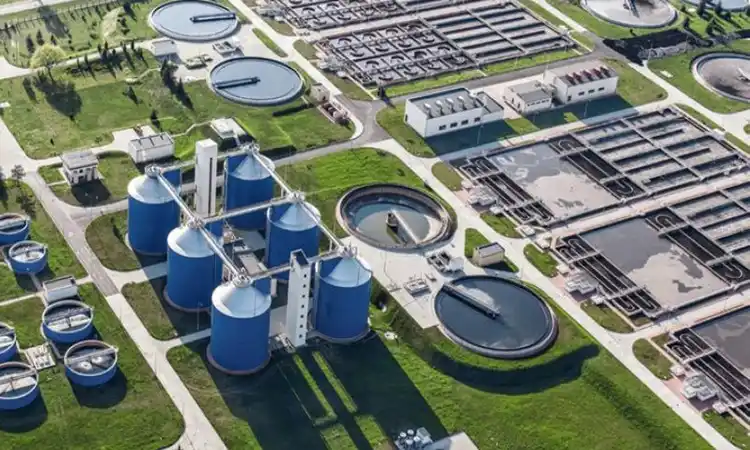A sewage treatment plant also known as a wastewater treatment plant or effluent treatment plant is a facility designed to treat and process sewage and wastewater from residential, commercial, and industrial sources. The primary objective of a sewage treatment plant is to remove contaminants, pathogens, and pollutants from wastewater before it is discharged back into the environment or reused for non-potable purposes.
Key components and processes typically found in a sewage treatment plant:
- Inflow and Screening: Wastewater enters the sewage treatment plant through inflow pipes. In the initial stage, large debris, such as plastics, sticks, and rocks, is removed through screening mechanisms like bar screens or mechanical screens. This step helps prevent damage to downstream equipment and ensures the smooth flow of wastewater.
- Primary Treatment: In the primary treatment phase, solid particles and organic matter are settled and removed from the wastewater. This is achieved through processes like sedimentation, where gravity allows heavier particles to settle at the bottom of settling tanks (primary clarifiers) as sludge, while lighter materials float and are skimmed off (scum). The partially treated water, known as effluent, moves to the next stage.
- Secondary Treatment: The secondary treatment phase focuses on reducing the organic content and biological contaminants in the wastewater. This is typically done using biological processes, such as activated sludge treatment or aerobic digestion, where microorganisms break down organic matter into simpler forms. Oxygen is often supplied to support aerobic microbial activity and promote decomposition.
- Tertiary Treatment (Optional): Some sewage treatment plants include a tertiary treatment stage for further purification and polishing of the effluent. Tertiary treatment may involve additional processes like filtration (sand filtration, membrane filtration) to remove fine particles, chemical treatment (chlorination, UV disinfection) to kill pathogens, or advanced oxidation to degrade organic compounds.
- Sludge Treatment and Disposal: The sludge collected during primary and secondary treatment processes undergoes further treatment to reduce its volume, stabilize its properties, and minimize environmental impact. Common sludge treatment methods include anaerobic digestion, where microorganisms break down organic matter in the absence of oxygen to produce biogas, and dewatering processes (centrifugation, drying beds) to remove excess water from the sludge. The treated sludge may be disposed of in landfills, used as fertilizer (after further treatment), or incinerated for energy recovery.
- Effluent Discharge or Reuse: After undergoing primary, secondary, and optionally tertiary treatment, the effluent is typically discharged into receiving water bodies (such as rivers, lakes, or oceans) in compliance with environmental regulations. In regions facing water scarcity or where wastewater reuse is feasible, treated effluent may be recycled for irrigation, industrial processes, or non-potable water applications after additional treatment and disinfection.
How Sewage Treatment Plant Works?
Inflow and Screening:
- Wastewater from residential, commercial, and industrial sources enters the sewage treatment plant through inflow pipes.
- Large debris, such as plastics, sticks, and rocks, is removed in the initial screening process using bar screens or mechanical screens. This step prevents damage to downstream equipment and ensures a smoother flow of wastewater.
Primary Treatment:
- After screening, the wastewater moves into primary settling tanks, also known as primary clarifiers.
- In these tanks, solid particles and organic matter settle to the bottom as sludge, while lighter materials float to the surface as scum. Mechanical scrapers or skimmers remove the sludge and scum for further treatment and disposal.
Secondary Treatment:
- The partially treated wastewater from primary clarifiers enters the secondary treatment stage, where the focus is on reducing the organic content and biological contaminants.
- One common secondary treatment method is the activated sludge process. Here, wastewater is mixed with activated sludge (microorganisms) in aeration tanks. Oxygen is supplied to support aerobic microbial activity, which breaks down organic matter into simpler forms.
- After aeration, the wastewater and activated sludge mixture enters secondary clarifiers, where the settled sludge is returned to the aeration tanks for continued treatment, and the clarified water (effluent) moves forward for further processing.
Tertiary Treatment (Optional):
- Some STP plants include a tertiary treatment stage for additional purification of the effluent.
- Tertiary treatment may involve processes like filtration (sand filters, membrane filters) to remove fine particles, chemical treatment (chlorination, UV disinfection) to kill remaining pathogens, or advanced oxidation to degrade organic compounds further.
Sludge Treatment:
- Sludge generated during primary and secondary treatment undergoes separate treatment processes.
- One common method is anaerobic digestion, where microorganisms break down organic matter in the sludge in the absence of oxygen, producing biogas (a mixture of methane and carbon dioxide).
- The digested sludge may undergo dewatering processes (centrifugation, drying beds) to reduce its moisture content and volume.
Effluent Discharge or Reuse:
- The treated effluent from the secondary and tertiary treatment stages is typically discharged into receiving water bodies (rivers, lakes, oceans) in compliance with environmental regulations.
- In regions where water reuse is feasible, the treated effluent may undergo additional treatment (such as disinfection) to meet quality standards for reuse in irrigation, industrial processes, or non-potable applications.
Conclusion
Overall, sewage treatment plants play a crucial role in protecting public health, safeguarding the environment, and promoting sustainable water management by treating and purifying wastewater before its release back into the ecosystem.
Learn more about the importance of wastewater management by exploring our article on sustainable water treatment practices. Go to home page
